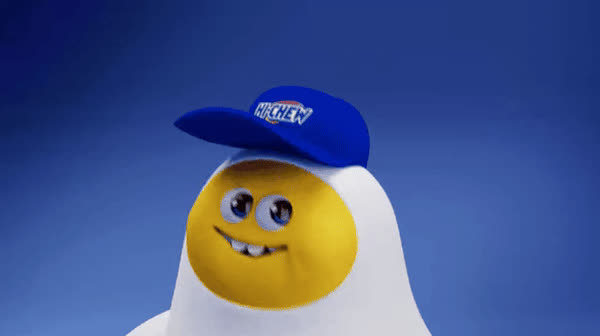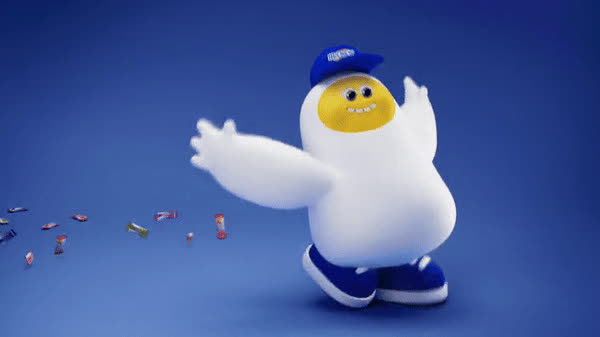

Almost 50 years after it was first created, the Japanese candy brand Hi-
Chew just introduced a new mascot—and it’s just as chewy-looking and
lovable as the real, sweet-tooth-curing thing.
Chewbie is a genderless, blob-like creature that looks like something
akin to a much cuter Michelin Man. It has puffy white arms, a goofy
smile, bright blue sneakers, and, according to his creators, “perpetually
sticky fingers.” Hi-Chew quietly debuted Chewbie late last month, but is
more officially rolling it out this week, starting with an integration
Tuesday night on Jimmy Kimmel Live.
The new brand mascot comes as Morinaga, Hi-Chew’s parent company,
looks to expand its reach in the U.S.—and as brand mascots are
experiencing something of a resurgence in American pop culture.
SUBSCRIBE
Hi-Chew’s new mascot, Chewie, is a
puffy, lovable lesson in branding
Mascots are making a comeback. Hi-Chew’s Chewbie exemplifies why.
06-12-24│ 15 minutes ago
[Image: Hi-Chew]
BY GRACE SNELLING 4 MINUTE READ
[Image: Hi-Chew]
THE MASCOT RENAISSANCE
Hi-Chew has been a popular candy in Japan since the early ‘70s, and made
its way to the U.S. in 2008. In the past few years, though, it’s been seeing a
breakthrough in popularity. According to the company, U.S. Hi-Chew sales
grew from $8 million in 2012 to $100 million in 2021, with further gains of
around 30% since then. Brand awareness also passed 50% in the past two
years.
Subscribe to the Design newsletter. The latest innovations in design
brought to you every weekday
Now, Morinaga America has set itself a lofty goal of hitting $250 million in
sales by 2030, which the company plans to achieve in part by bringing
more unique products from its HQ in Japan over to the U.S. in the coming
years. That kind of revenue increase also necessitates a big boost in brand
recognition among American consumers, and that starts with Chewbie.
There’s a good reason to introduce a mascot now, even if it’s 50 years after
the candy’s debut. Brand mascots are having a moment in the sun—with a
bit of a surrealist twist. Brands like Duolingo and Pop Tarts are leaning into
wacky mascot-based antics to attract a Gen Z audience, whether that be
through viral stunts at the Super Bowl or trend-based videos on TikTok.
Same with the 2024 Paris Olympics, which introduced the somewhat
esoteric, completely adorable Phryges mascot. Mascots have historically
had an important place in food branding (think the classic cereals of your
youth), but, now, brands are finding new ways for mascots to embody a
brand’s persona—and to appear just about everywhere.
“Duolingo is kind of setting the table stakes; that’s what everyone’s looking
to these days,” says Mitchell Fait, executive creative director of Gigasavvy,
the creative agency that helped bring Chewbie to life. “How can a mascot
not only represent the brand, but also get into pop culture and become a
part of the conversation every single day, in new and vibrant ways? I think
that’s something that old-school mascots stayed away from: You had your
exact lane, and you couldn’t break out of the guardrails.”
[Image: Hi-Chew]
DESIGNING A NEW MASCOT AFTER 50 YEARS
To design a versatile mascot, Fait’s team tackled a few top considerations:
Look, personality, and lore.
In simplest terms, Chewbie is an embodiment of a Hi-Chew candy (mango,
to be exact). But Fait’s team didn’t want it to look exactly like the product
itself, à la M&M’s or Sour Patch Kids.
A key part of Hi-Chew’s appeal to consumers, Fait says, is the feeling that
it’s not a big corporation. Its initial cult following in the U.S. gravitated
toward the brand due to its perception as an “underdog,” Fait adds. “How
can we hold onto that die-hard following and ethos while we bring it to
mass market?” Fait asks. “We have to control it, so it doesn’t lose its cool
factor.”
Part of the solution, he says, is making Chewbie a bit quirky. Its arms are
too long; its teeth are too big; and its body looks slightly disproportionate.
All of this adds to Chewbie’s appeal. Personality-wise, the look fits:
Chewbie is meant to be “different,” a tad mischievous, and “an instigator of
fun.” It’s a description that seems especially geared toward Chewbie’s
gradual transformation into the brand’s primary spokesperson-slash-
symbol, especially on social media, where a hint (or even a heavy dose) of
deviousness seems to be the recipe for success.
Beyond just its outward appearance, the Gigasavvy team also worked to
come up with detailed lore for Chewbie. A visit to its dedicated web page
reveals that it’s 11-Hi-Chews-tall, speaks its own language called
“Chewlish,” enjoys skateboarding, and listens to Jojo Siwa and Chappell
Roan. This builds a more holistic persona for the mascot and allows it to
easily plug into pop culture conversations, just as Duolingo did with its
mascot’s Dua Lipa obsession. And, hey, it’s fun.
According to Joanne Hsu, Hi-Chew’s senior brand marketing manager, fans
can expect Chewbie to appear in various ways across the brand in the
coming months—from packaging and socials to merch and even potential
in-person experiences.
In essence, Hi-Chew’s Chewbie—and the related rise of brand mascots—
speaks to the changing ways younger consumers engage with brand
content: on Tiktok, in online conversations, and as entertainment.
“We want Chewbie to be present in the conversation Gen Z is having,” Hsu
says.
The application deadline for Fast Company’s World Changing Ideas Awards
is this Friday, December 6, at 11:59 p.m. PT. Apply today.
ABOUT THE AUTHOR
Grace Snelling is a contributor for Fast Company with a focus on product design,
branding, advertising, art, and all things Gen Z. Her stories have included an exploration
into the wacky world of water branding, a chat with Questlove about his creative-centric
YouTube series, and a look into Wayfair’s first-ever physical store More
ADVERTISEMENT
Fast Company & Inc © 2024 Mansueto Ventures, LLC
Advertise Careers Subscribe Privacy Policy Notice of Collection Permissions Help Center About Us Sitemap
Fastcompany.com adheres to NewsGuard’s nine standards of credibility and transparency. Learn More